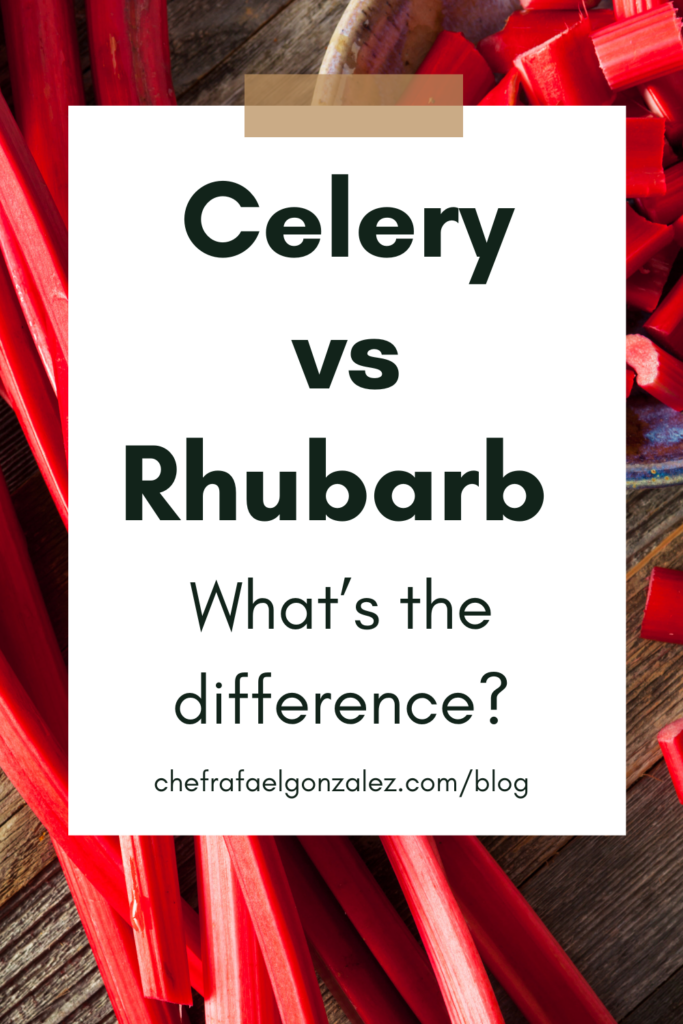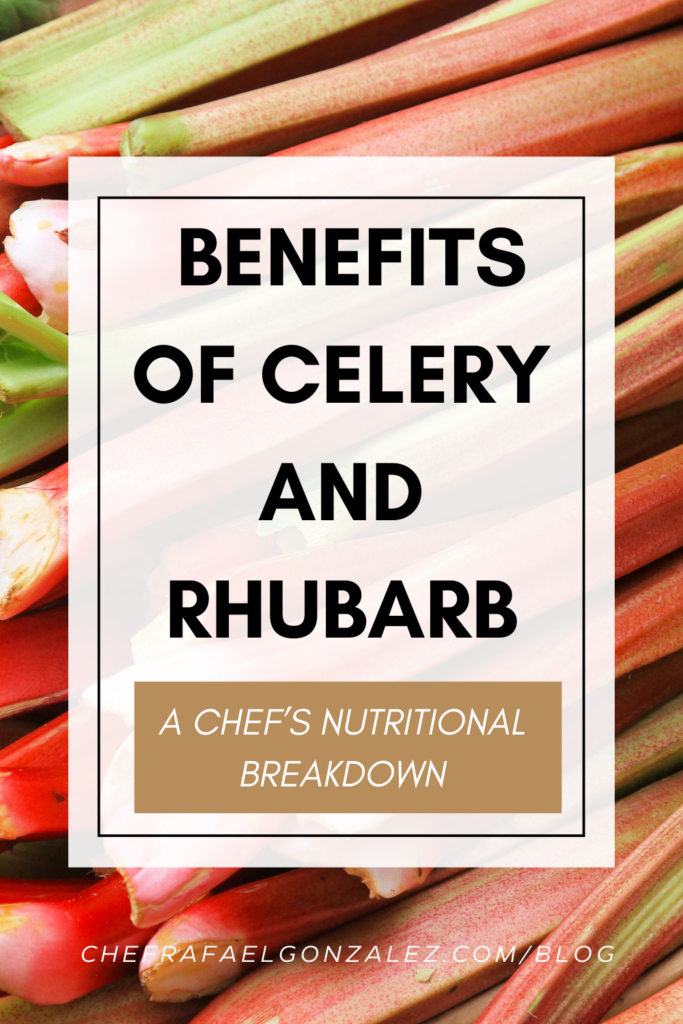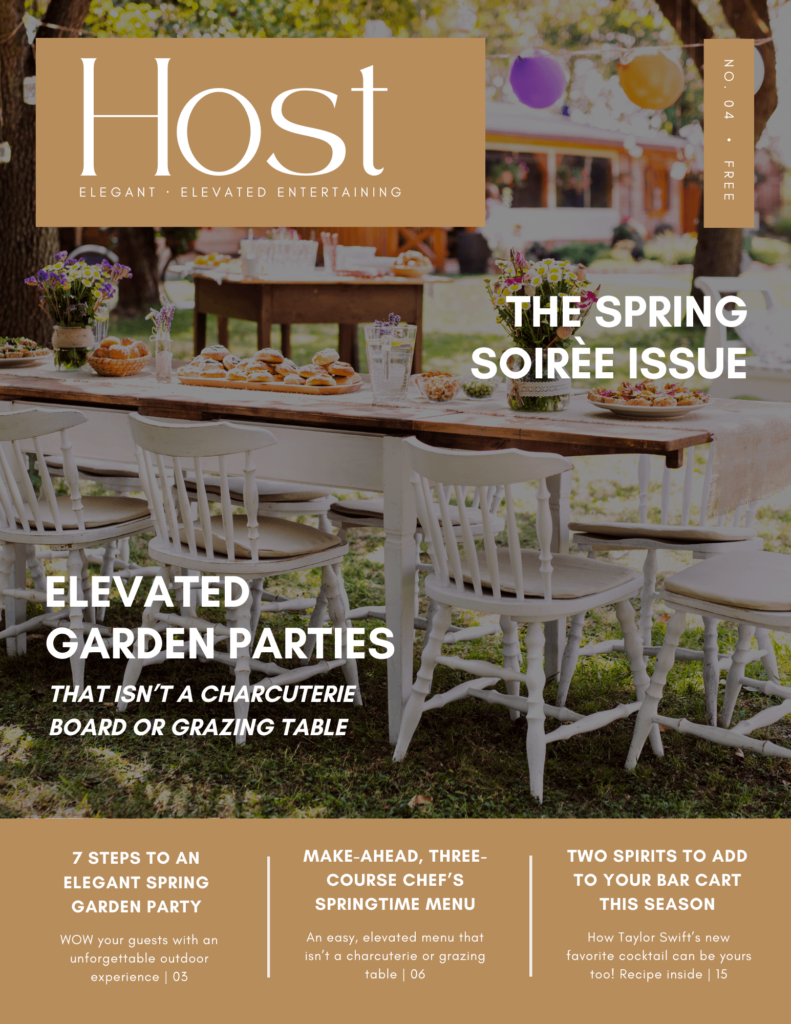
Introduction to Rhubarb and Celery
At first glance, the colorful stalks of rhubarb might remind you of celery stalks, with their thick, fibrous texture and elongated shape. But they are totally different. Rhubarb, with its tangy flavor and vibrant colors ranging from deep red to light green, makes a great addition to sweet desserts and jams. They also complement a nice foie terrine if you’re craving something special and out of the ordinary.
On the other hand, celery, instantly recognized for its crunchy texture and ability to blend seamlessly into savory dishes, holds a different kind of culinary possibilities Throughout this post, we’re trying to dissolve the common confusion between these two, revealing not just the visual differences but the different roles they play in our kitchens.
From the tangy punch of a strawberry-rhubarb pie to the crisp freshness of a celery side dish, let’s uncover the distinctive qualities that celebrate each plant’s unique contribution to our taste buds.
Botanical Background
At first glance, the vibrant colors of the red rhubarb set it apart. These thick stalks, bursting with a very tart taste, belong to a plant family quite different from that of celery.
Celery, with its crunchy texture, shares its green hues with the large green leaves of rhubarb. And that’s where the similarities end.
Rhubarb, often mistaken for a fruit due to its culinary use in desserts, comes from the Rheum rhabarbarum species.
The main difference between the two lies in their growth habits. Rhubarb thrives in cooler climates, its red stalks signaling its appearance for the first time in farmers markets across North America. This perennial plant can return for several years, offering its signature sour tang.
Celery, on the other hand, prefers wet, fertile lands. Cultivated as an annual, it lends its crisp bite to savory dishes and crunchy snacks. These unique characteristics showcase the distinct roles each vegetable plays in our kitchens.
You can quickly discover that rhubarb and celery are used totally differently.

Culinary Uses for Rhubarb
With its vibrant colors and sour taste, is usually the star in sweet desserts. The stalks of the plant give a unique sour tang to dishes like strawberry rhubarb pies and rhubarb jam, tickling your taste buds if you’re looking for that blend of sweet and tart.
Rhubarb has a distinct presence in various regional cuisines across the United States, but it is particularly prominent in the Northern states and Midwestern states. The cooler climates of these regions provide the ideal growing conditions for rhubarb, leading to its popularity and frequent use in local culinary traditions.
In states like Minnesota, Michigan, and Wisconsin, rhubarb is a springtime favorite, often harvested and celebrated in community festivals and local markets from late April through June.
Rhubarb is renowned for its use in traditional desserts. It is most commonly used in pies, where its tartness beautifully complements sweet fruits like strawberries, creating the beloved strawberry-rhubarb pie—a staple in many Northern American homes during the spring and early summer. This combination is so cherished that it has become a symbol of the season in many parts of the Midwest.
Beyond its rustic, homey connotations in pies and crumbles, rhubarb also appears in more refined culinary settings. High-end restaurants in metropolitan areas such as New York and Chicago creatively incorporate rhubarb into both sweet and savory dishes, showcasing its versatility.
Chefs like me use it in everything from elegant compotes served alongside rich meats or foie gras to delicately balanced desserts that feature its sour profile as a counterpoint to sweet, creamy elements.
Thus, while not typically associated with Southern cuisine or as ubiquitous nationwide as ingredients like celery, rhubarb holds a special place in the culinary landscape of the United States, particularly in regions where its growth is abundant and in dishes that allow its unique flavor to shine.

Culinary Uses for Celery
On the other hand, celery, resembling rhubarb in its stalky appearance, but green color, veers towards the savory side of the flavor spectrum.
Its crunchy texture and mild flavor have an important role for different dishes. Whether served as a crisp side dish or finely chopped in a small dice to add depth to savory meat dishes, celery is versatile.
These two vegetables can transform a meal, from the refreshing tang of rhubarb’s sour flavor in a dessert to the subtle, earthy undertones celery brings to a main course.
In New Orleans, celery plays a crucial role in one of the foundational elements of local cuisine known as the “Holy Trinity.” Alongside onions and bell peppers, celery forms this trio that serves as the base for countless Creole and Cajun dishes, infusing them with deep flavors and aromas.
This combination is similar to the mirepoix in French cooking or the sofrito in Spanish culinary traditions. In the kitchens of New Orleans, the Holy Trinity is sautéed to create a flavorful foundation that enhances everything from gumbo and jambalaya to étouffée and red beans and rice. The inclusion of celery adds a subtle bitterness and earthy notes, which balances the sweetness of the onions and the slight piquancy of the bell peppers, creating a harmonious blend that is essential to the region’s gastronomic identity.
These two vegetables can transform a meal, from the refreshing tang of rhubarb’s sour flavor in a dessert to the subtle, earthy undertones celery brings to a main course. Many times, one doesn’t see or taste the celery on its own, but it complements the dish and enhances the recipe.
Nutritional Profiles
There’s a nutritional treasure hidden within the colorful stalks of rhubarb and crunchy celery.
Both offer a wealth of vitamins and minerals, important for maintaining a healthy balance. Rhubarb, with its vibrant red stalks, emerges as a significant source of vitamin K, essential for blood clotting and bone health. It doesn’t stop there; vitamin C and vitamin A find their places within these thick stalks, contributing to immune system support and eye health, respectively.
Celery, on the other hand, stands out for its vitamin K content as well. Yet, it brings to the table a rich supply of vitamin C. This crunchy vegetable, likened to raw rhubarb stalks in texture but not in taste, floods our system with anti-inflammatory benefits and antioxidant support.
Each bite of celery offers a refreshing crunch that carries with it vitamin a, vitamin e, and vitamin b, facilitating a range of bodily functions from energy metabolism to nerve function.
Their unique compositions make rhubarb and celery not just ingredients for your next culinary adventure but add to your goals towards a balanced diet. Adding a food plant, like rhubarb and celery into our meals, whether as a tangy rhubarb jam, compote, a soothing side dish of celery, or the Cuban trifecta of celery-onions-bell peppers invites not just new flavors but a ton of health benefits.
These subtle, yet impactful, benefits clearly show the importance of considering variety not just for the taste buds, but for our body’s nutritional needs.

Health Benefits
Rhubarb and celery are both unique in their nutritional profiles and health benefits, making them valuable additions to a diverse and balanced diet. Here’s how each contributes to health:
Rhubarb
- Dietary Fiber: A cup of rhubarb provides a good amount of dietary fiber, which is essential for digestive health. It helps regulate bowel movements and can aid in weight management by promoting a feeling of fullness.
- Blood Sugar Management: Rhubarb’s fiber can also help in managing blood sugar levels by slowing down the absorption of sugar into the bloodstream, which is beneficial for those monitoring their sugar intake.
- Vitamin K and Calcium: Rhubarb is an excellent source of Vitamin K, which is necessary for blood clotting and bone health. It’s also an excellent source of calcium, which is crucial for healthy bones and teeth.
- Medicinal Purposes: Historically, rhubarb has been used in herbal medicine, primarily for its purgative properties. It is believed to help cleanse the body and improve liver health.
Celery
Healthy Fatty Acids: While low in fat, celery contains small amounts of healthy fatty acids, including omega-6. These fatty acids are important for maintaining healthy skin and promoting proper brain function.
- High Blood Pressure: Celery is known for its potential effects on lowering high blood pressure. It contains phytochemicals called phthalides, which can relax the tissues of the artery walls to increase blood flow and reduce blood pressure.
- Excellent Source of Antioxidants: Celery provides antioxidants like vitamin C and flavonoids, which help prevent oxidative stress and may reduce the risk of chronic diseases such as cardiovascular disease.
- Root Vegetable Benefits: As a root vegetable, celery is rich in essential minerals and soluble and insoluble fibers, which can aid in digestion and maintaining heart health.
- Both rhubarb and celery offer distinct health benefits. Rhubarb’s rich fiber and mineral content make it beneficial for bone health and blood sugar management, while celery’s antioxidants and phthalides support cardiovascular health and can help prevent heart attacks. Including both vegetables in your diet can contribute to a well-rounded intake of nutrients beneficial for overall health.
Rhubarb’s Unique Features
We discovered the unique charm of rhubarb, a plant that grabs your attention with its vibrant red color and sour flavor profile. Unlike the mild-mannered celery, rhubarb’s colorful stalks burst and show up mostly in spring time desserts.
Its distinctive sour taste can challenge our culinary creativity, You might have had a strawberry rhubarb pie during the spring at one point….or at least have seen it on the supermarket shelves and aisles. Strawberry is a popular ingredient to mix with the stalks of the rhubarb plant. However, adventurers beware: the large green rhubarb leaves that crown the thick stalks contain toxins, so stay away from that part.
Our Easter family celebration led us to think beyond traditional fruit pies.
We combined the tangy essence of fresh rhubarb with sweet strawberries in a Strawberry Rhubarb Vanilla Bean Rice Pudding.
It was a hit.
It not only awakened taste buds but also highlighted its potential beyond the sour tang. Rhubarb, with its rich vitamins c, k, and a, proved itself a great addition to our Easter Sunday menu, transforming a simple dessert (a Rice Pudding) into an unforgettable experience for the family. There were no leftovers!
Celery’s Versatility
In all of our kitchens, celery has played such an important role. Its crunchy texture became a base for both raw snack experiences (we’re talking about you Chicken Wings!) and important components of our most cherished soups and savory dishes. We discovered its unparalleled ability to combine seamlessly with a ton of flavors, blending well without overpowering.
Every time we served homemade Chicken Wings, either doused in Buffalo Sauce or dressed in our Korean Sweet and Spicy Sauce, celery was the unsung hero on the plate. It’s almost incomplete without a side of celery stalks.
This versatile vegetable, with its refreshing crunch, pairs perfectly with the tangy zip of blue cheese or the cool creaminess of ranch. Its simplicity complemented and balanced the Chicken Wings with each bite, making the dining experience so much better. Can you even imagine having wings without celery these days?

Handling and Preparation Tips
We understand selecting the perfect stalks from the grocery stores or farmers markets is crucial. For rhubarb, you’ll want thick stalks with bright colors, signaling their freshness. Don’t forget to avoid the large green leaves which are toxic.
Celery, on the other hand, should boast firm, green stalks. Storing them properly ensures they retain their crispness. Place stalks of rhubarb in a cool, dark place, and keep celery submerged in cold water in the refrigerator.
Preparing these veggies demands care. Quick revival for celery includes soaking the stalks in a little water (cold) to bring back its crunch.
Working in fine dining restaurants introduces a variety of meticulous culinary techniques aimed at enhancing the dining experience, one of which is the careful preparation of vegetables like celery. In these high-end culinary environments, celery is often peeled to remove the fibrous outer strings, ensuring a smoother, more delicate texture.
This detail, although seemingly minor, can significantly elevate a dish. By peeling celery, you can incorporate it seamlessly into refined dishes without the distraction of its natural fibrousness, allowing the subtle, slightly bitter flavor of celery to complement other ingredients more effectively. This technique exemplifies the attention to detail that characterizes fine dining, where every element of a dish is considered and refined to contribute to a harmonious and sophisticated eating experience.
In THIS YouTube video, we’re showing you how to store rhubarb properly and 4 other spring vegetables you want to have (Chef’s Recommendations) and enjoy for the spring season.
Seasonal Availability
We often find ourselves strolling through grocery stores or visiting farmers markets in search of fresh produce. Among our finds, rhubarb and celery stand out for their seasonal availability in the United States and North America.
Rhubarb, with its bright red hue and thick stalks, makes its first appearance in early spring. This is a period of anticipation for us, as its availability does not live long. It only lasts maybe only 5-6 weeks out of the year. The short season of rhubarb just urges us to explore creative ways to include its distinctive sour flavor in our meals every spring.
In contrast, celery, with its crunchy texture and green hues, is available throughout the year. This allows us to integrate it into our dishes as a crunchy side dish or a savory base for soups, no matter what the season. The main difference in their seasonal availability leads us to treasure rhubarb for its brief presence, while relying on celery for consistent culinary use.
This contrast influences our approach to cooking and eating.
With rhubarb, we eagerly await its first appearance in the season after a cold winter to create sweet desserts or tangy jams. If you’re lucky enough, you might find rhubarb in the freezer section during the off-season.
For celery, we appreciate its versatility and readiness, making it an integral part of our menu planning.
Whether basking in the fleeting joy of rhubarb or enjoying the steadfast presence of celery, I always encourage home chefs to enjoy and savor the bounty of each season.

Innovative Recipes
I love experimenting with vegetables because you can transform ordinary ingredients into extraordinary dishes.
When I was a young cook in New York City coming from Miami, I was embarrassed that I didn’t know more than half the vegetables in the fine dining restaurants I worked at. This led me to explore the Union Square Farmers Market every time I had a day off on my own.
I spoke with the local vendors and farmers and began to educate myself on my days off. They were mostly spent at the Barnes and Noble where I spend a full day with my head buried in the cookbooks I couldn’t afford to buy for myself back then.
That journey led me to discover the versatility of rhubarb and celery, staples in kitchens across the United States. With vibrant colors and distinct flavors, these ingredients brought creative flare to our meals. I took on the challenge of incorporating them in innovative ways, and this last Easter, I started with a dessert that captured the essence of spring.
We crafted a Strawberry Rhubarb Vanilla Bean Rice Pudding, a dish that became the highlight of our Easter family celebration. This dessert married the sweet strawberries and rhubarb’s sour tang along with the subtle fragrance and flavor of fresh vanilla beans. (You can can the full recipe in THIS free issue of our cooking and entertaining guide)
WOW.
The combination was not merely a delight for our taste buds but a testament to rhubarb’s potential beyond its traditional use in strawberry rhubarb pie which you might see in grocery stores everywhere.
Working at high-end restaurants, I loved serving rhubarb with a roasted duck breast, foie gras or as a jam with a cheese course or cheese board.
On other weekends, celery, often relegated to the role of a side dish or snack always pairs beautifully with homemade Chicken Wings in Buffalo Sauce or our Korean Sweet and Spicy Sauce. We always, always serve it with a side of celery, and little bowls of blue cheese or ranch.
Celery is a versatile and essential ingredient in many beloved dishes, notably in Jambalaya and classic Bolognese sauce. In Jambalaya, a staple of Creole cooking, celery forms part of the “Holy Trinity” alongside onions and bell peppers.
This combination creates a flavor base that is both robust and aromatic, essential for the rich and spicy notes characteristic of this Louisiana favorite. Similarly, in a classic Bolognese sauce, celery is finely chopped and sautéed with onions and carrots to form a ‘soffritto’, which imparts a subtle bitterness and depth that balances the sweetness of the tomatoes and the richness of the meat. (If you’re craving a restaurant-style Bolognese but don’t have the 4 hours to simmer the meat, try our popular Simplified Spaghetti Bolognese HERE)
A culinary tip for both amateur cooks and seasoned chefs is to not discard the celery leaves. These leaves are packed with flavor and can be chopped and added towards the end of cooking for a bright, slightly peppery note, enhancing the overall taste of the dish.
Whether blended into the background of a sauce or used as a fresh garnish, celery, including its leaves, contributes a valuable dimension to various culinary creations.

Exploring the Flavors
We’ve just had this flavorful adventure with rhubarb and celery! We compared and contrasted the vibrant colors and textures of rhubarb with the crisp, refreshing nature of celery.
Now its time to turn your kitchen in your own lab! Experimenting is good and challenges your creativity! Don’t be afraid to make mistakes.
I can’t tell you how many mistakes I made in the kitchen before I got to where I am today.
Just imagine the thrill of folding fresh rhubarb into fruit pies or simmering it into rich, tangy rhubarb compote. Its sour flavor, a perfect complement to the sweetness of strawberry in the iconic strawberry-rhubarb pie, leaves us craving for more.
Want to add a simple wow-factor to your classic cheesecake? Top the fresh rhubarb jam to elevate and otherwise plain cheesecake.
On the other hand, celery’s ability to blend into savory dishes or stand alone as a crunchy side dish cannot be understated. Its thick stalks, very similar to those of the rhubarb plant, differ greatly in taste and culinary use, yet together, they form the backbone of innovative and creative cooking.
We encourage you to dive into the world of rhubarb and celery. Let their distinctive flavors inspire new dishes, fueling both creativity and a love for cooking.
The joy of crafting meals that sing with these two ingredients will, without a doubt, enrich your culinary ventures.

The Last Bite: Savoring the Stalks
What a revelation to see how these seemingly similar stalks differ, from their botanical roots to their roles on our plates.
Rhubarb, with its sour tang and versatile nature, can dazzle you in desserts like the unforgettable strawberry-rhubarb vanilla bean rice pudding. You absolutely must try it! This dish alone demonstrated rhubarb’s ability to transform the ordinary into extraordinary.
Celery, on the other hand, brought its crunchy, savory presence into our kitchens, proving indispensable in dishes ranging from raw snack sticks to integral components of soups and salads.
Their nutritional profiles further highlighted their unique contributions to our diets. Rhubarb, rich in vitamin K and C, alongside celery, packed with vitamins A and E, showed us that eating well doesn’t mean sacrificing flavor.
Remember the importance of large green leaves when it comes to rhubarb — not for consumption, but as a sign of freshness — and the technique of reviving celery’s crunch by soaking in cold water. Both require mindful handling and preparation, yet offer endless culinary experiments.
As we close this blog post on rhubarb and celery, let’s carry forward the excitement for incorporating these versatile stalks into our meals.
Whether it’s reimagining side dishes or discovering new savory or sweet concoctions, the adventure in taste and health benefits is just beginning. We’ve seen firsthand how rhubarb’s sour taste can be balanced in a dessert or how celery’s crunch can elevate a simple dish.
Now, it’s your turn to explore and enjoy the diverse, flavorful experiences that await in your kitchen with rhubarb and celery. What will you be making? Let us know!
If you want a copy of the full recipe of the STRAWBERRY-RHUBARB VANILLA BEAN RICE PUDDING that we made for Easter, you can get it all HERE when you sign up to receive your FREE copy of HOST Magazine, your guide to cooking and entertaining.

Be the first to comment